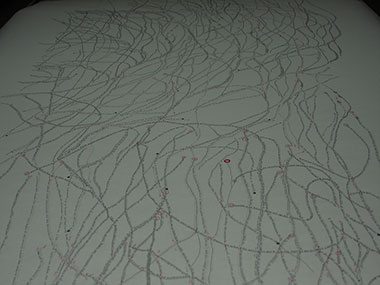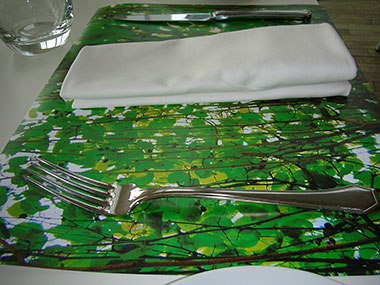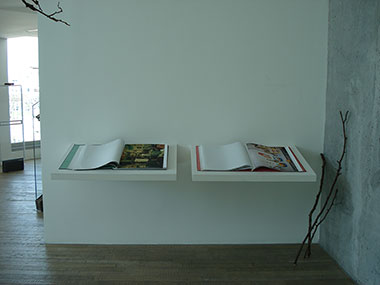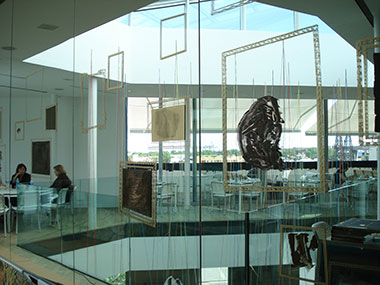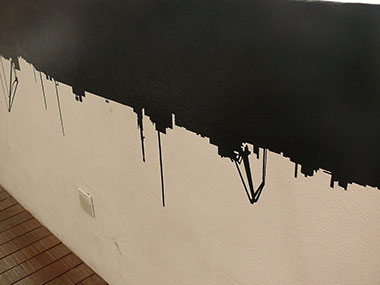Mar�a In�s Drangosch
- Intervention at Proa Library: “Recolectora de paisajes”
The artist Inés Drangosch intervenes in the bookstore space with her work Gatherer of landscapes (Recolectora de paisajes), continuing to work alongside Fundación Proa in its program to promote contemporary action in the foundation’s spaces. The intervention, which Ana Gallardo curates, interweaves word and image in works where poetry, reflection and beauty are present.
The work
The artistic exercise that Inés Drangosch has been practicing in her latest works is simple and subtle drawings on paper. Exercising the habit of appropriation, she draws poetry.
She works meticulously over different papers, which are generally thin and translucent, like tracing paper, and are suggestive of air, water or light. This is where she deposits the words she has taken from her readings.
De los mapas al jardín, 2009
She takes various texts and unites them, forming prolific, subtle, labyrinthine vines, the same ones that grow on the wall that separates her garden from her house.
For Inés, these dry, intertwined branches in winter, ferment her new designs of interlocking poems. In the pieces exhibited, she works with texts from Juarroz, Bukowski and Rimbaud.
She rewrites each of them and turns them into nature. With these independent texts, she organizes a new plot, a reading that is organized and at the same time arbitrary.
Maps of poetry (Mapas de poesía), 2009
She represents cartography, paths composed by words, giving the viewer references so that, having become an anonymous explorer, he may move from writing to writing, from branch to branch, reading from the top, backwards, towards the edges, or to the first word, a shared spring bud.
In so doing, possible new terrains are constantly being planted, being brought to question.
Leaves for … (Hojas para…), 2006
She translates her own poems to color codes in graph paper.
Rimbaud, 2009
In Rimbaud, as she reads A Season in Hell, she covers the book with tape and gently “waxes” the words until the text is engraved in the tape. She carefully stacks the leftovers in a soft, secret and irreverent grouping, like chips from a wood carving.
Just trying again and again these minimal gestures, so as to give order to a new nature.
El jardín de las delicias, 2009
Print on paper, 30 x 40 cm.
Drangosch's vines reach the cafeteria in the form of place-mats, adding color to each of the tables. The feature the artist's berry tree. Related to landscape, this piece portrays nature photographically to underline the visual forms that determine its beauty.
Gatherer of landscapes. Ana Gallardo
When Inés goes out to her garden, she finds words.
She passes from here to there.
She finds them fallen, crossed, periods, commas, accents.
Each of them is wet with dew.
She dries them.
It would seem their beloved poets have left them, dawn by dawn, text by text, scattered in the grass, along the garden walls, the edge of the pool, under a lemon tree, beside the lilies.
She is careful in gathering them, like the harvester, she bends down and she bends down again, searching one by one for that desired word, that word read and read again.
Later, she forms a great climbing plant of interwoven texts; they cling tight to the wall, like a lover, leaving an impression, a trace not to be forgotten.
Like the water that runs, they fall and mingle, they confuse themselves, one with the other, organizing new texts.
She rewrites, like nature, the poems she wants, she takes from them, forming a new landscape.
From time to time she leaves us a guide to rediscover the path,
Small numbers that determine the return to that first place, to that first word, to a shared beginning.
Maps of poetry, offering several possible readings
She reads a book, covers it with a paper tape that she then pulls up, erasing the text.
First, she empties them as if turning over a bag, concealing her abandonment among the grass, of what she reads and what she feels.
Later, meticulously, she arranges small strips of uprooted words
delicately, and she stacks them in a suave, secrecy and irreverent grouping.
All together, as if they were the remains of a wood carving.
Sawdust, fine and poetic.
Once again lets start again.
Another tour through a new nature, through a new landscape, through a new poem.
Ana Gallardo, Buenos Aires, 2009
Fernanda Laguna
Beauty and Happiness
From the branch of a tree hang the most treasured books edited by Fernanda Laguna in “Beauty and Happiness.” The space Fernanda chose provokes an intimate encounter, surprising in a place of such circulation. The presence of the branch enhances the natural origin of the paper, linking mind and nature, and also emphasizing the contrast with the clear modern space of the institution. We find ourselves beside the frail branch that, with fishing line, holds up the photocopies of texts that dance in the air, waiting to be read. Laguna, with these carefully compiled materials, manages to create an atmosphere of private reading and reflection in an institutional context.
Two books of photographic memoirs from “Beauty and Happiness” accompany this work, which is a key piece of art from the last years.
"Me gusta sentir que es realmente una biblioteca ambulante. Ella es parte del paisaje urbano, tanto en este caso, con su editorial en rama, como en la calle, en las puerta de una inauguración con su valija repleta de libros. Acompañan esta obra 2 libros de memorias fotográficas de “Belleza y Felicidad”, pieza clave del arte local de los últimos tiempos".
“I like feeling that it really is an itinerant library. It is part of the urban landscape, both in this case, with the publishing house on the branch, and in the street, or in the doors of an inauguration with a suitcase full of books,” says Laguna.
Daniel Joglar
The distance between things, 2009
This piece, made with wools and wooden rods, rescues everyday materials to create abstract sculptural works that form a geometric design. The artist attempts to create sculptures that have no inside, playing with the idea of the boundary between the interior and exterior. Always interested in science and its linkages with art, Joglar looks to illustrate the lines that operate in the space, in works that also refer to architecture, minimalism, and the work of Fred Sandback. Joglar often works with collected objects and materials that he stores and chooses specifically for his installations. The artist describes his way of working in a presentation on the Bola de Nieve site: “... the process has to do with (...) the chain reaction that awaken my works. My installations generally require from the observer a more studied viewing.”
The distance between things calls the viewer to a new landscape with figures and multiple structures, where vision is fractured, proposing lines and open fragments. Wools, wooden rods and other materials were found, selected and collected by the artist to be turned into objects of contemplation where the fragile sculpture interacts and works together with the architecture of the space.
Mariela Scafati
Brown, 2009
Mural. Wall mirror, screen printing and painting
250 x 240 cm
Mariela Scafati intervenes on the wall of the Proa Café with the work "Brown", a wall of mirrors with screen-printed or hand-painted frames that indicate the details of the reflected landscapes. In so doing, the work provokes an exchange of glances that complicates the space, seeking to enhance the absurdity of each architectural form and the geometries that are produced. The choice of the palette of browns links the piece to the color of the river, an effect primarily achieved through the mirrored reflections.
The mirror intervenes again in the cafeteria, challenging the perception of the surrounding Boca landscape, inserting itself in these surroundings in an awesome, almost imposing manner. “The mirror would enhance the architectural form; to see this image replicated, something unfamiliar to any architecture that would appear inhabitable; to see replicated something so familiar from our outside surroundings (...) It is the magic of the word of an artist, who simply said, so simple and so beautiful and so transforming," said the artist about the contemplation of her work.
The fragile and reflective nature of the mirror also alludes to the fragility of the landscape, the perceptive changes and the visual field surrounding us. In this way it is related to another of the works of Boundary that explores the limits: of the real space of Proa and its linkages with La Boca, and with interior and exterior architecture. The mirror, as another reflection, and also the paintings on the frames, act as boundaries between the outside world and the representation of the interior.
Marcela Sinclair
Brown, 2009
Mural. Wall mirror, screen printing and painting
250 x 240 cm
Mariela Scafati intervenes on the wall of the Proa Café with the work "Brown", a wall of mirrors with screen-printed or hand-painted frames that indicate the details of the reflected landscapes. In so doing, the work provokes an exchange of glances that complicates the space, seeking to enhance the absurdity of each architectural form and the geometries that are produced. The choice of the palette of browns links the piece to the color of the river, an effect primarily achieved through the mirrored reflections.
The mirror intervenes again in the cafeteria, challenging the perception of the surrounding Boca landscape, inserting itself in these surroundings in an awesome, almost imposing manner. “The mirror would enhance the architectural form; to see this image replicated, something unfamiliar to any architecture that would appear inhabitable; to see replicated something so familiar from our outside surroundings (...) It is the magic of the word of an artist, who simply said, so simple and so beautiful and so transforming," said the artist about the contemplation of her work.
The fragile and reflective nature of the mirror also alludes to the fragility of the landscape, the perceptive changes and the visual field surrounding us. In this way it is related to another of the works of Boundary that explores the limits: of the real space of Proa and its linkages with La Boca, and with interior and exterior architecture. The mirror, as another reflection, and also the paintings on the frames, act as boundaries between the outside world and the representation of the interior.
Ismael Pinkler
Acapellas, 2009
Sound Intervention
Ismael Pinkler composes a sound intervention that dialogues with the contaminated sound-scape on the Fundación PROA terrace. The intention of the work is not to add to the mass of noise but rather to underline the already existing sounds with others that are more subtle and create doubts about the origins of the mass, inducing passersby to listen more carefully than is their custom. “The work is designed for involuntary listeners who chose to be in the place where this develops for other reasons, and may or may not pay attention to what happens,” says Pinkler about his production.
Known for producing electronic sounds in the style of “ambient,” Pinkler creates Acapellas by recording sounds from the cinema, composing original music for the occasion and using pre-recorded material, thus generating different sound sequences that achieve dialogue with the Boca sound-scape “The title Acapellas makes reference to a kind of remix,” Pinkler says, “of pop tunes in which only the voices are left, allowing the DJ to mix them with an instrumental base and compose a new song out of something that already exists, made only for the moment.” Pinkler presents the landscape from the perspective of sound, managing to awaken imagination and mystery using commonplace elements.


